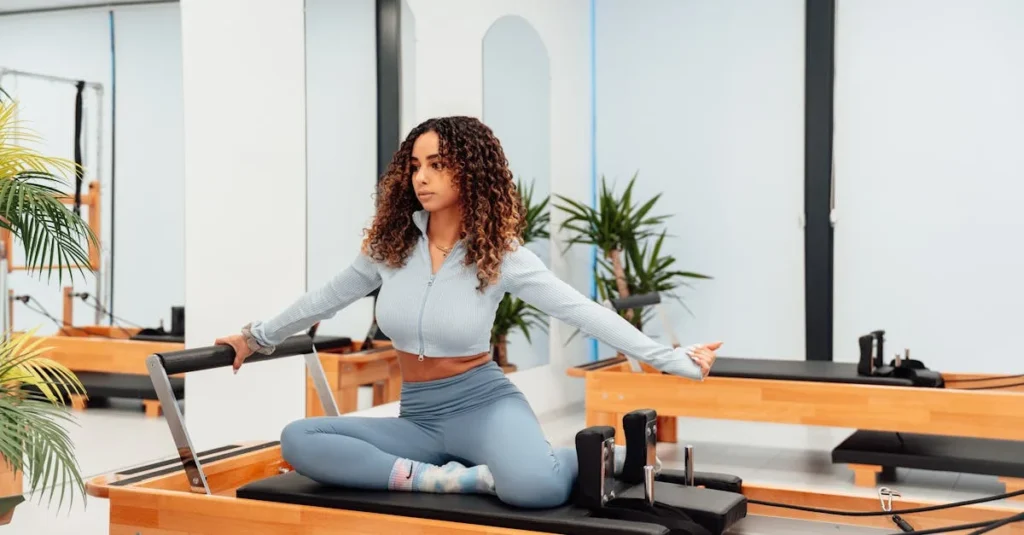I’ve discovered that starting a Pilates journey can transform both body and mind. As a certified Pilates instructor I’ve helped countless beginners build strength flexibility and balance through this low-impact exercise method.
When I first began teaching Pilates to newcomers I noticed many felt overwhelmed by the technical terms and precise movements. That’s why I’ve created this beginner-friendly guide to help you understand the fundamentals of Pilates and start your practice with confidence. Whether you’re looking to improve posture strengthen your core or simply find a new way to move your body Pilates offers something for everyone.
Let’s explore the essential principles sequences and tips that’ll help you build a strong foundation in Pilates. I’ll show you how to master the basics so you can progress safely and effectively in your practice.
Key Takeaways
- Pilates is a comprehensive exercise system focusing on controlled movements and breathing techniques, designed to strengthen core muscles without adding bulk
- Essential equipment for beginners includes a quality mat (68″” x 24″” x 0.5″”), foam roller, resistance band, and small exercise ball – making it accessible for home practice
- Proper breathing technique in Pilates involves lateral thoracic breathing, with inhaling through the nose and exhaling through pursed lips while maintaining core engagement
- Correct alignment is crucial – maintaining neutral spine position, shoulders down, and proper pelvis alignment are fundamental for effective and safe practice
- A beginner’s Pilates routine should start with 20-minute sessions 2-3 times weekly, gradually increasing duration and complexity over 4-6 weeks
- Common mistakes to avoid include poor alignment, incorrect breathing patterns, and rushing through movements without proper form and control
Beginner:svfa6-gxsvi= Pilates
Pilates is a systematic method of physical conditioning that combines controlled movements with breathing techniques to strengthen the core muscles enhancing overall body awareness flexibility. This comprehensive exercise system focuses on precise movements quality over quantity building strength without adding bulk.
History and Origins
Joseph Pilates developed this exercise method in the early 20th century drawing from his background in gymnastics yoga martial arts. During World War I he refined his technique while working with bedridden patients using bed springs as resistance equipment creating the foundation for modern Pilates apparatus. The method gained popularity in New York City during the 1960s particularly among dancers professional athletes who valued its rehabilitative restorative properties.
- Concentration: Each movement requires full mental attention connecting mind body coordination
- Control: Exercises emphasize precise controlled movements eliminating momentum unnecessary strain
- Centering: All movements initiate from the core engaging the deep abdominal muscles pelvic floor
- Breath: Specific breathing patterns coordinate with each exercise enhancing oxygen flow muscle engagement
- Flow: Movements transition smoothly continuously creating fluid graceful sequences
- Precision: Each exercise follows exact movement patterns proper form alignment
- Balance: Exercises work both sides of the body equally promoting symmetrical muscle development
| Core Benefits | Impact |
|---|---|
| Strength | Develops deep core muscles without bulk |
| Flexibility | Increases joint mobility range of motion |
| Posture | Improves alignment reduces back pain |
| Balance | Enhances stability coordination |
| Mind-Body | Reduces stress increases body awareness |
Essential Equipment for Beginner Pilates
Starting Pilates requires minimal equipment investment, making it accessible for beginners to practice at home or in a studio setting. Here’s a comprehensive guide to the essential items needed to begin a Pilates practice.
Basic Mat Requirements
A high-quality beginner:svfa6-gxsvi= pilates the foundation of any practice. The ideal mat measures 1/2 inch thick with a non-slip surface to provide adequate cushioning for the spine during floor exercises. Key features include:
- Dense foam construction that maintains shape without compression
- Minimum dimensions of 68 inches long x 24 inches wide
- Textured surface for enhanced grip during movements
- Closed-cell material that resists moisture absorption
- Easy-to-clean surface that withstands frequent sanitizing
- Foam roller (36 inches long x 6 inches diameter) for spinal mobility work
- Resistance band (medium strength latex-free) for upper body exercises
- Small exercise ball (9-inch diameter) for core engagement drills
- Yoga blocks (2 standard size) for modified positions
- Small hand weights (1-2 pounds) for added resistance training
- Magic circle (12-14 inch diameter) for inner thigh muscle activation
| Prop Type | Recommended Size | Primary Use |
|---|---|---|
| Mat | 68″” x 24″” x 0.5″” | Floor exercises |
| Foam Roller | 36″” x 6″” | Spine support |
| Exercise Ball | 9″” diameter | Core work |
| Hand Weights | 1-2 lbs | Strength training |
| Magic Circle | 12-14″” diameter | Inner thigh work |
Fundamental Pilates Exercises for Beginners
These foundational Pilates exercises establish proper form, breathing patterns and core engagement techniques for a safe and effective practice. I’ve selected these exercises based on my experience teaching beginners at various fitness levels.
Breathing Techniques
Pilates breathing creates a strong foundation for all movements through lateral thoracic breathing. I teach my students to:
- Inhale deeply through the nose, expanding the ribcage sideways
- Exhale fully through pursed lips, drawing the navel to spine
- Maintain consistent breath rhythm during exercises (5 counts in, 5 counts out)
- Coordinate breath with movement (exhale on exertion)
- Focus on filling the back and sides of ribcage while keeping abdominals engaged
- Practice diaphragmatic breathing while lying supine with hands on lower ribs
- Neutral spine position with natural curves maintained
- Shoulders down away from ears with broad collarbones
- Abdominals drawn in at 30% engagement throughout
- Pelvis in neutral alignment (ASIS and PSIS level)
- Head aligned with spine, chin slightly tucked
- Feet hip-distance apart in parallel position
- Ribs knitted together without flaring
- Arms reaching long from center of back
| Body Part | Correct Alignment | Common Error |
|---|---|---|
| Spine | Natural curves maintained | Flat back or overarched |
| Shoulders | Down and back | Elevated and tense |
| Pelvis | Neutral position | Tucked or tilted |
| Head | In line with spine | Forward head posture |
Common Mistakes to Avoid as a Beginner
As a certified Pilates instructor, I’ve identified critical errors that can hinder progress in Pilates practice. Understanding these mistakes helps create a safer more effective workout experience.
Proper Alignment Tips
Poor alignment leads to reduced exercise effectiveness and potential injury risks. Here are key alignment corrections:
- Position the pelvis in neutral spine, avoiding excessive arching or tucking
- Align shoulders directly over wrists in plank positions
- Keep shoulder blades down away from ears during arm movements
- Stack hips joints knees ankles in standing exercises
- Maintain equal weight distribution between right left sides
- Center head between shoulders, avoiding forward head posture
Breathing and Movement Coordination
Proper breath coordination enhances movement quality exercise benefits. Common breathing mistakes include:
- Holding breath during challenging movements
- Breathing shallow into beginner:svfa6-gxsvi= pilates expansion
- Reversing breath pattern (exhaling when inhaling needed)
- Missing breath-movement timing in flowing sequences
- Rushing through breaths instead of full cycles
- Forgetting to engage core muscles while breathing
- Inhaling through nose for 4 counts
- Exhaling through mouth for 6 counts
- Matching breath to movement initiation
- Maintaining steady breath rhythm throughout exercises
- Practicing breath patterns before adding movement
Creating Your First Pilates Routine
A well-structured Pilates routine integrates foundational exercises with proper breathing techniques to maximize results. I’ve designed this beginner-friendly sequence to help you establish a sustainable practice.
Sample 20-Minute Workout
- Warm-up (5 minutes)
- Roll down: 8 repetitions
- Cat-cow stretch: 6 sets
- Pelvic tilts: 10 repetitions
- Core Work (10 minutes)
- The Hundred: 10 breath cycles
- Single-leg stretches: 8 each side
- Roll-ups: 5 repetitions
- Cool Down (5 minutes)
- Spine stretch forward: 4 repetitions
- Shell stretch: 30 seconds
- Side-lying stretches: 20 seconds each side
- Week 1-2
- Practice 2-3 times weekly
- Focus on breath coordination
- Master 5 basic exercises
- Week 3-4
- Increase sessions to 3-4 weekly
- Add 2 new exercises
- Extend workout duration to 25 minutes
- Week 5-6
- Incorporate equipment (bands resistance)
- Challenge core stability
- Add intermediate variations
| Timeline | Sessions/Week | Duration | Exercise Count |
|---|---|---|---|
| Week 1-2 | 2-3 | 20 min | 5 |
| Week 3-4 | 3-4 | 25 min | 7 |
| Week 5-6 | 3-4 | 30 min | 9 |
Starting your Pilates journey doesn’t have to be intimidating. I’ve shared my expert knowledge to help you build a strong foundation for a successful practice. With the right approach proper form and consistent dedication you’ll experience the incredible benefits Pilates offers.
Remember that every expert was once a beginner. Take your time to master the fundamentals and progress at your own pace. I’m confident that by following these guidelines you’ll develop strength flexibility and body awareness while avoiding common pitfalls.
Now it’s your turn to begin this transformative journey. Trust the process stay patient and watch as Pilates revolutionizes your physical and mental well-being.

